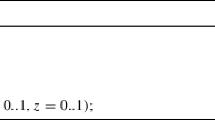Abstract
In many practical situations, we need to make a group decision that takes into account preferences of all the participants. Ideally, we should elicit, from each participant, a full information about his/her preferences, but such elicitation is usually too time-consuming to be practical. Instead, we only elicit, from each participant, his/her ranking of different alternatives. One of the semi-heuristic methods for decision making under such information is Borda count, when for each alternative and each participant, we count how many alternatives are worse, and then select the alternatives for which the sum of these numbers is the largest. In this paper, we explain the empirical success of the Borda count technique by showing that this method naturally follows from the maximum entropy approach—a natural approach to decision making under uncertainty.
Access this chapter
Tax calculation will be finalised at checkout
Purchases are for personal use only
Similar content being viewed by others
References
Ahsanullah, M., Nevzorov, V.B., Shakil, M.: An Introduction to Order Statistics. Atlantis Press, Paris (2013)
Arnold, B.C., Balakrishnan, N., Nagaraja, H.N.: A First Course in Order Statistics, Society of Industrial and Applied Mathematics (SIAM). Pennsylvania, Philadelphia (2008)
David, H.A., Nagaraja, H.N.: Order Statistics. Wiley, New York (2003)
Fishburn, P.C.: Utility Theory for Decision Making. Wiley, New York (1969)
Jaimes, A., Tweedie, C., Magoc, T., Kreinovich, V., Ceberio, M.: Selecting the best location for a meteorological tower: a case study of multi-objective constraint optimization. In: Ceberio, M., Kreinovich, V. (eds.) Constraint Programming and Decision Making, pp. 61–66. Springer, Berlin (2014)
Jaynes, E.T., Bretthorst, G.L.: Probability Theory: The Logic of Science. Cambridge University Press, Cambridge (2003)
Kosheleva, O., Kreinovich, V., Lorkowski, J., Osegueda, M.: How to transform partial order between degrees into numerical values. In: Proceedings of the 2016 IEEE International Conferences on Systems, Man, and Cybernetics SMC 2016, Budapest, Hungary, 9–12 October 2016
Kreinovich, V.: Decision making under interval uncertainty (and beyond). In: Guo, P., Pedrycz, W. (eds.) Human-Centric Decision-Making Models for Social Sciences, pp. 163–193. Springer, Heidelberg (2014)
Lorkowski, J., Kreinovich, V.: Interval and symmetry approaches to uncertainty – pioneered by Wiener – help explain seemingly irrational human behavior: a case study. In: Proceedings of the 2014 Annual Conference of the North American Fuzzy Information Processing Society NAFIPS 2014, Boston, Massachusetts, 24–26 June 2014
Lorkowski, J., Kreinovich, V.: Likert-type fuzzy uncertainty from a traditional decision making viewpoint: how symmetry helps explain human decision making (including seemingly irrational behavior). Appl. Comput. Math. 13(3), 275–298 (2014)
Lorkowski, J., Kreinovich, V.: Granularity helps explain seemingly irrational features of human decision making. In: Pedrycz, W., Chen, S.-M. (eds.) Granular Computing and Decision-Making: Interactive and Iterative Approaches, pp. 1–31. Springer, Cham (2015)
Lorkowski, J., Kreinovich, V.: Fuzzy logic ideas can help in explaining Kahneman and Tversky’s empirical decision weights. In: Zadeh, L., et al. (eds.) Recent Developments and New Direction in Soft-Computing Foundations and Applications, pp. 89–98. Springer, Cham (2016)
Luce, R.D., Raiffa, R.: Games and Decisions: Introduction and Critical Survey. Dover, New York (1989)
Nguyen, H.T., Kosheleva, O., Kreinovich, V.: Decision making beyond Arrow’s ‘impossibility theorem’, with the analysis of effects of collusion and mutual attraction. Int. J. Intell. Syst. 24(1), 27–47 (2009)
Raiffa, H.: Decision Analysis. McGraw-Hill, Columbus (1997)
Saari, D.G.: Chaotic Electrions!. American Mathematical Society, Providence (2001)
Saari, D.G.: Disposing Dictators, Demystifying Voting Paradoxes: Social Choice Analysis. Cambridge University Press, New York (2008)
Acknowledgments
This work was supported in part by the National Science Foundation grants 1623190 (A Model of Change for Preparing a New Generation for Professional Practice in Computer Science) and HRD-1242122 (Cyber-ShARE Center of Excellence).
Author information
Authors and Affiliations
Corresponding author
Editor information
Editors and Affiliations
Rights and permissions
Copyright information
© 2021 The Editor(s) (if applicable) and The Author(s), under exclusive license to Springer Nature Switzerland AG
About this chapter
Cite this chapter
Kosheleva, O., Kreinovich, V., Wei, G. (2021). Ranking-Based Voting Revisited: Maximum Entropy Approach Leads to Borda Count (and Its Versions). In: Sriboonchitta, S., Kreinovich, V., Yamaka, W. (eds) Behavioral Predictive Modeling in Economics. Studies in Computational Intelligence, vol 897. Springer, Cham. https://doi.org/10.1007/978-3-030-49728-6_9
Download citation
DOI: https://doi.org/10.1007/978-3-030-49728-6_9
Published:
Publisher Name: Springer, Cham
Print ISBN: 978-3-030-49727-9
Online ISBN: 978-3-030-49728-6
eBook Packages: Intelligent Technologies and RoboticsIntelligent Technologies and Robotics (R0)




